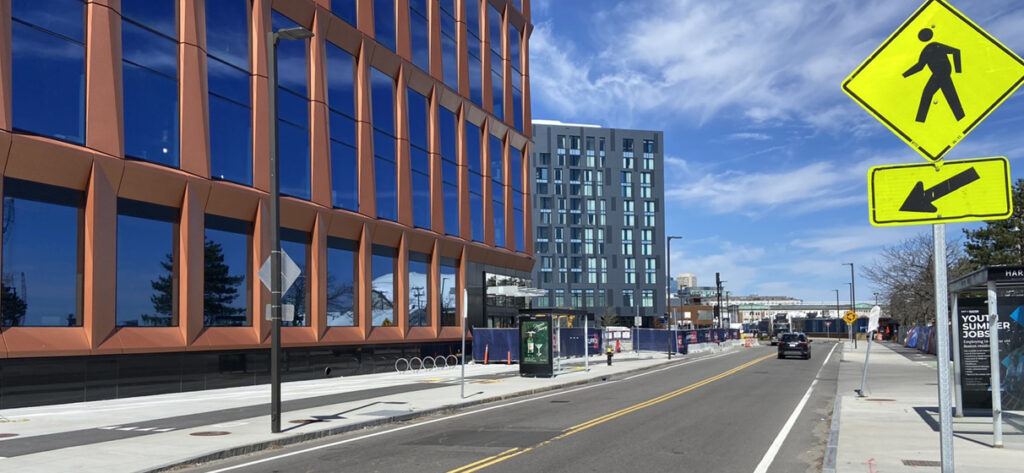In recent years, cities across the United States have experienced a rise in programs aimed to make these communities more inclusive, sustainable and responsive to diverse user needs.
In South Boston, STV’s role supporting the continued operation of Raymond Flynn Marine Park is a prime example of how urban infrastructure can evolve to serve both long-standing industrial sectors and an influx of new industries and visitors. STV led the design for this program, which redefines what it means to create a truly “complete street,” where infrastructure balances traditional and modern demands on shared spaces, offering a blueprint for other cities to follow.
Redesigning a Major Artery for All Users
One of the most ambitious aspects of this program was reimagining Northern Avenue, a crucial link between the Marine Park and the surrounding Seaport District. Historically a significant route for industrial traffic, Northern Avenue was essential for connecting the area’s seafood processing facilities, breweries and repair docks. With the area shifting towards more diverse industrial uses, specifically biotech and high-tech lab space, the Marine Park’s user base expanded, prompting a need to create safer and more accessible infrastructure for pedestrians, cyclists and public transit users without compromising the vital needs of the area’s industrial base.
STV’s redesign incorporated several innovative features to make Northern Avenue a model for complete streets. By reconfiguring the existing roadway, the design team freed up space to include sidewalk-level bike lanes and improved sidewalks, creating safer and more efficient ways for pedestrians and cyclists to navigate the area. Raised pedestrian crossings and floating bus stops for the Massachusetts Bay Transit Authority (MBTA) further enhanced safety, reinforcing the project team’s commitment to making the corridor more inclusive and accessible.

Prioritizing Safety with Data-Driven Design
Safety was a major focus throughout the project. Thorough Autoturn analyses and 3D modeling allowed the design team to see to it that trucks could still navigate the streets safely – a vital consideration given the park’s active industrial role. These analyses proved vital to gaining stakeholder confidence, demonstrating that the new, multi-modal street design would not hinder the heavy traffic flow required by local businesses.
At the same time, design elements like new street lighting, additional trees, and separated bike lanes make Northern Avenue feel approachable for more vulnerable road users. The raised pedestrian crossings at intersections serve to calm traffic, providing added visibility and creating a buffer for pedestrians and cyclists. This multifaceted approach underscores how data and user-centered planning can create functional, inviting spaces that serve everyone’s needs.

Stakeholder Collaboration: A Model for Complex Urban Projects
The success of the Marine Park project is largely attributable to effective stakeholder collaboration. STV worked closely with several city and state agencies, such as the Massachusetts Department of Transportation, the Boston Public Improvement Commission, and the Boston Fire Department, to bring a shared vision to life. The team engaged in extensive discussions with the Marine Park Tenants Association, ensuring that businesses that rely on efficient trucking routes could continue to thrive even with the addition of new urban amenities.
Through ongoing collaboration, the project team aligned competing priorities to support the region’s economic evolution while safeguarding the needs of legacy industries. Such coordination is increasingly essential as urban environments face pressure to accommodate both industrial and commercial users in high-density spaces.
By balancing the old with the new, the new and improved Raymond Flynn Marine Park serves as a beacon for thoughtful, inclusive design that can drive economic growth and urban vitality in diverse and historically significant neighborhoods.








